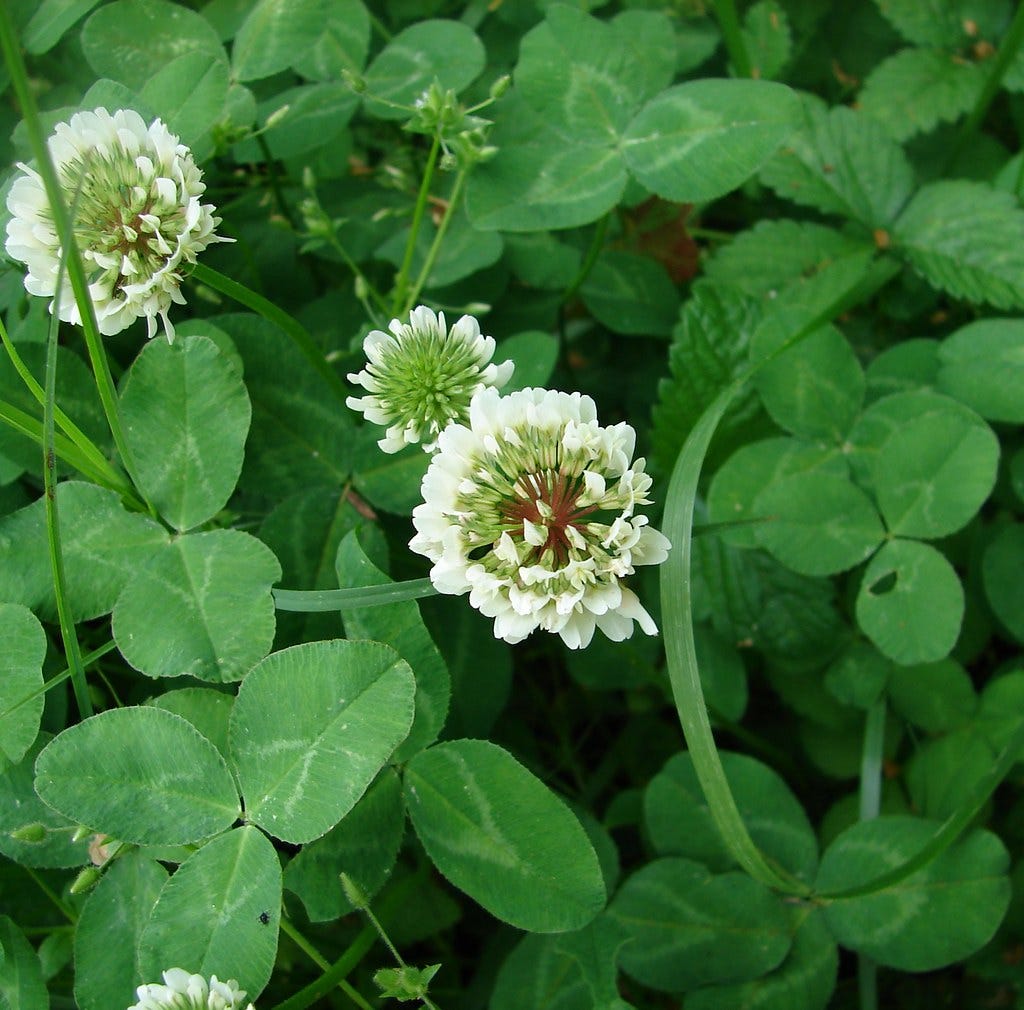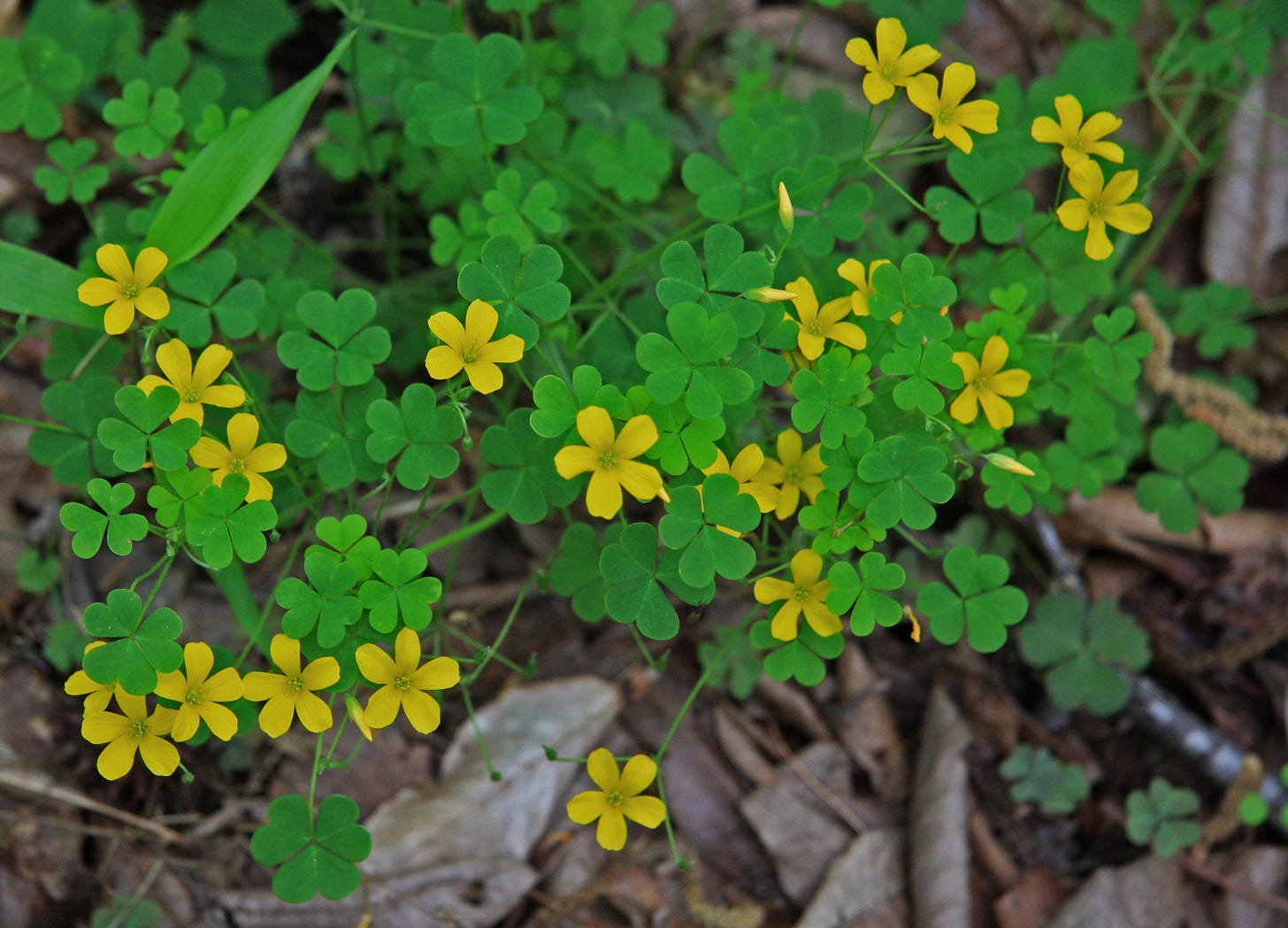not the matted rhizomatic, feather-leaved white clover
Or the aptly named purple oxalis triangularis, with its - triangle leaves. Though they are related.
ALSO KNOWN AS: Oxalis stricta, Sour grass, lemon clover, common yellow oxalis, pickle plant
How you know:
yellow five petaled flowers
three perfectly heart shaped leaves
can grow up to inches tall, or lie sprawled on the ground, but they are usually much shorter than that.
Chartreuse may be obvious. It is a campy and unsubtle color. Yet it draws the eye to it. The colors in the natural world communicate with us, and in many environments chartreuse is blinds itself because it is so common.
Yellow wood sorrel is chartreuse; yet if it asks us anything, it is not to take it for granted.
Yellow wood sorrel can also have tinges of copper, purple, or a darker green. But that bright green is a stunning glow in a summer wood. They grow in small clumps along the borders of deciduous forests like wreaths of small green hearts, delicate as the bellies of newts. If you don’t know them you might miss them, running your eyes over the three leaves of clovers, believing them to be all the same. As a child, yellow wood sorrel was the first plant I knew I could eat, and this was a powerful knowledge.
It’s hard not to think of the youth when I look at this small plant. The specific green of yellow wood sorrel is indicative of spring and, more broadly, as a new beginning of life. Spring, as we all know if we really take stock, is not a mere celebration of life. The season is a hard time. The beginning of life does not correspond to the length of it. This green looks like it has a light inside it, so glowing with yellow that it is nearly transparent. It’s easy to forget the strength within a plant that is in this vulnerable state of spring. But they have wrenched themselves from the armor of seeds, they have grown with immense force through the soil, toward light and air. They have been drowned by water, pressed by passing feet and they have lived.
This green that the wood sorrel exudes throughout its life reminds us of spring. They are the first to emerge in with that vibrant green cast from the roiling waves of upturned soil.
Related to shamrocks, and purple wood sorrel. There are many kinds of wood sorrel and many variations on this plant. Yellow wood sorrel is native to North America and parts of Eurasia. Some have a purple cast, and they grow normally in partial shade and generally moist soil. They grow in the northeast US and into Canada. A wide range of animals eat it, and, small though it is, it is a pollinator, of course.
The leaves fold at night like tiny origami umbrellas and open again with the sun. Wood sorrel has physical a circadian rhythm, called nyctinasty, meaning it moves to a sleeping position at night. As they get older they become rhizomatic. But for the early part of their lives they remain a single plant. Their stems grow alternately until they whorl at the top of the plant by the flowers.
The flowers with subtle rays number between two and seven per plant. There is a close relation to the yellow wood sorrel, the southern wood sorrel (Oxalis dillenii) whose only difference is that there are consistently two yellow flowers and the hairs are slightly different and there are white ridges on the seeds, so get your magnifying glasses out. But they are both edible… so. One imagines the kind of circumstances that have happened for the Oxalis dillenii to differentiate itself the way it did: what those small white ridges might mean to the seed.
Similar to jewelweed, these small plants also have bursting seed pods. The verb for a bursting seed pod is to dehisce which comes from the Latin to gape, or related to hiscere, derivative of the word hiare "to yawn". Though miniature in comparison to the relatively towering jewelweed, their seeds can jump three times the length of the plant itself, like being able to jump the length of an regular sized unground swimming pool. The stricta in their name comes from the way their seed pods stand upright and that the plants themselves grow upright. The seed pods extend out of the dying flower in a membrane with a protective and insulating layer of hair.
While wood sorrel is edible - it tastes amazing - and is medicinal, used as an astringent and diuretic. However, eaten in large quantities it can become toxic due to its high level of oxalic acid, which is not uncommon in leafy greens, nuts, seeds, and cacao. Oxalic acid or oxolate binds to minerals in the gut making it harder to absorb nutrients. So if you have issues with kidneys it isn’t recommended to eat much of. But it would be quite hard to do this anyway. Awareness is wisdom. Oxalic acid is used in dyeing, bleaching and printing. The term oxalic came from the very substance within these clovers in Greek and has to do with piercing up, or sharpness. Sure to wake you up.
A myth for yellow wood sorrel
The plantmaker created the yellow wood sorrel for the children. With her smooth hands of April wind she wanted to create a being that had all the curiosity of the child to be made into plant form. Though these plants are small they are meant for eyes of children to find, ones that are attuned to the slight movements of life, with their acidic taste they jolt the world to life. Within the yellow wood sorrel his is the taste of beginnings. Each small yellow flowers are beacons calling us to care for them, and for the earth on which they live. Because of this the youngest of a group should always be the first to eat the yellow wood sorrel once you have identified it, and taught them to see it too. Yellow wood sorrel has a magic that will awaken the child within you.
Forager Friendly! Despite their slight and collective cloudlike form, they have a sharp acid taste, like a lemon, which gives them that name: lemon clover. All parts of the plant are edible, but due to the amount of oxalic acid in the plant, be sure to avoid it if you have kidney problems or gout. A poultice can be used to treat swellings as they have a cooling quality.
If the whole plant is used, it can create an orange dye.
If you boil it you can use the stock to make tea, soup, or jam.
sources:
https://www.fs.usda.gov/wildflowers/plant-of-the-week/oxalis_stricta.shtml
https://mdc.mo.gov/discover-nature/field-guide/yellow-wood-sorrel
https://plants.ces.ncsu.edu/plants/oxalis-stricta/
https://hort.extension.wisc.edu/articles/common-yellow-woodsorrel-oxalis-stricta/
https://www.healthline.com/nutrition/oxalate-good-or-bad
https://www.youtube.com/watch?v=obpyh4eQk8Q
https://www.etymonline.com/search?q=oxalis
https://www.minnesotawildflowers.info/flower/yellow-wood-sorrel
https://www.bbg.org/article/weed_of_the_month_yellow_wood_sorrel







